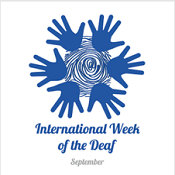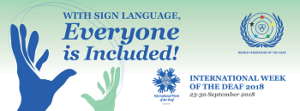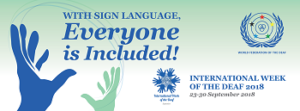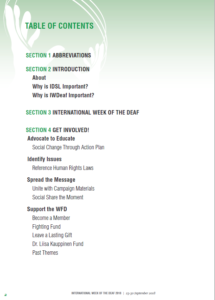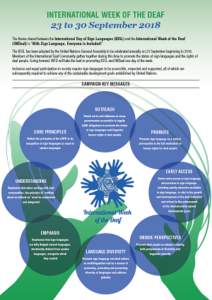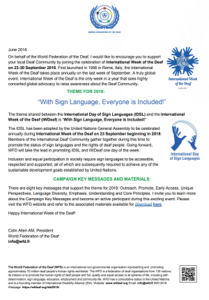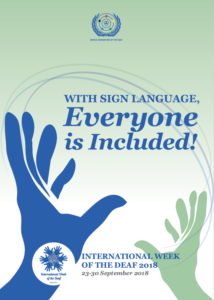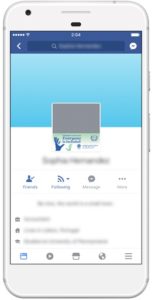INTERNATIONAL WEEK OF THE DEAF 2019

International Week of the Deaf (IWDeaf)
is an initiative of the WFD and was first launched in 1958 in Rome, Italy. It is celebrated annually by the global Deaf Community on the last full week of September to commemorate the same month the first World Congress of the WFD was held. IWDeaf is celebrated through various activities by respective Deaf Communities worldwide. These activities call for participation and involvement of various stakeholders including families, peers, governmental bodies, professional sign language interpreters, and DPOs.
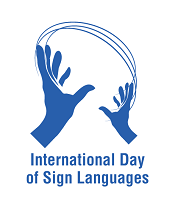
International Day of Sign Languages (IDSL)
has been adopted by the United Nations General Assembly and will be celebrated annually on 23 September beginning in 2019. The objective of the IDSL is to raise awareness on sign languages and strengthen the status about sign languages. This event also will take place as part of the International Week of the Deaf (IWDeaf), which is celebrated on the last full week of September.
2019 THEME
Sign Language Rights for All!
Reach out and influence
as many governments as possible to legally fulfill their obligations.
Promote deaf people as unique
in having both perspectives of disability and linguistic minority and that sign language and deaf culture strengthens multilingualism and are means of promoting, protecting and preserving diversity of languages and cultures globally.
Reflect the principles of the CRPD
in its recognition of sign languages as equal to spoken languages. Sign languages are fully-fledged natural languages, structurally distinct from spoken languages, alongside which they coexist.
Emphasise sign language as a critical prerequisite
to the full realisation of human rights for deaf people. Early access to sign language and services in sign language, including quality education available in sign language, is vital to the growth and development of the deaf individual and critical to the achievement of the internationally agreed development goals.
Stress “Nothing about us, Without us”
when working with Deaf Communities, the principle 'Nothing about us, Without Us' must be integrated.
HOW TO CELEBRATE INTERNATIONAL WEEK OF DEAF PEOPLE
SIGN LANGUAGE RIGHTS FOR ALL!
Monday, 23 September
Sign language is a critical prerequisite to ensure the full participation of deaf people in their communities and to ensure the full realisation of their human rights. Governments must provide support for early acquisition to sign language and provide inclusive quality bilingual education. In addition, governments must provide and fund professional and trained sign language interpreters to enable the participation of deaf people in society.
The legal recognition of national sign languages as official languages is critical for the inclusion of deaf people in their societies. This legal recognition will aid with the implementation and realization of the rights outlined in the United Nations Convention on the Rights of Persons with Disabilities (CRPD) and the 2030 Agenda, making the mottos “Nothing About Us Without Us” to “Leave No One Behind” a reality.
If you are campaigning for the legal recognition of your national sign language, prepare a lobbying campaign for this day and post it on social media! If your sign language has been recognised, tell us about it on social media with the hashtags #IDSL2019 #IWDeaf2019!
SIGN LANGUAGE RIGHTS FOR ALL CHILDREN
Tuesday, 24 Setpember
Sign language is a language deaf children can learn naturally. However, as 95% of deaf children are born to hearing parents who usually don’t know sign language, most of those children receive late exposure to sign language resulting in late cognitive development and less chance to acquire language proficiency. Early access to sign language and quality inclusive education through a national sign language and national written language for all deaf children is fundamental to ensuring their human rights. To secure this right, families of deaf children must receive state-funded sign language instruction as early as possible.
In addition, deaf children have the right to receive education in their natural language through quality inclusive bilingual education in a national sign language and national written language. Teachers must be fluent in sign languages with a native-level proficiency and deaf children must be surrounded by their deaf peers and deaf adult role models. These settings are crucial to the development of their identity.
Today, post a photo on social media of deaf children celebrating IWDeaf!
SIGN LANGUAGE RIGHTS FOR ALL
DEAF SENIOR CITIZENS
Wednesday, 25 September
The global population is increasingly ageing, and deaf people are a part of this trend. Some deaf senior citizens live in care centres and nursing homes where they can enjoy the companionship of other deaf people and with staff who use sign language. However, many others are isolated in places which do not provide services in sign language. As a result, deaf senior citizens do not benefit from their fundamental right to receive information and services in their national sign language. Truly inclusive environments for deaf seniors should ensure access to information and social settings in sign languages. Public authorities must ensure all information destined for senior deaf citizens is accessible in their national sign language and service providers have fluent sign language skills for deaf senior citizens to be given the same opportunities as others.
In some countries Deaf Seniors also have their own organizations and clubs. Are you a deaf senior citizen? Hold an event with other deaf senior citizens and celebrate our deaf heritage! And be sure to share these events on social media with the hashtags #IDSL2019 #IWDeaf2019.
SIGN LANGUAGE RIGHTS FOR DEAFBLIND PEOPLE AND DEAF PEOPLE WITH DISABILITIES
Thursday, 26 September
DeafBlind people and deaf people with disabilities, including Deaf Plus, are fully-fledged members of deaf communities and have the right to participate in these communities and in society at large on an equal basis. Access provisions for peoples with disabilities are important to ensure access for all members of deaf communities.
In addition to access to sign languages, DeafBlind people will sign varieties of sign language, including protactile language, and sign language interpretation services that are designed for Deafblind people. Such an interpretation may also include environmental description and guiding, as well as tactile signs.
Deaf people with additional disabilities, including deaf people on the autism spectrum and deaf people with intellectual disabilities, have the right to live their lives with self-determination and with access to sign language environments, in educational, residential, and social settings. With access, deaf people with disabilities can achieve full participation, equality, independence and self-determination in all areas of life.
Today, let us celebrate deaf communities by ensuring we are always inclusive of all deaf people. Share our diverse communities on social media with the hashtags #IDSL2019 #IWDeaf2019
SIGN LANGUAGE RIGHTS FOR DEAF WOMEN
Friday, 27 September
The global gender rate indicates the ratio of women is larger than that of men, thus deaf women can be said to represent the majority of the deaf population. Article 6 of the CRPD specifically recognises that women and girls with disabilities, including deaf women, are at risk of being subject to intersectional discrimination. Specific measures must be implemented to safeguard gender equality, diversity and equal participation in society and in decision-making processes for all deaf people. National governments and all other stakeholders must take measures to ensure the full development, advancement, empowerment and equal participation of deaf women in their society and community. Deaf women must have the opportunity to enjoy their human rights in all spheres of life!
In many countries, deaf women have created their own organisations for self-advocacy and education purposes. Today, let us recognise the need to ensure gender equality in our communities and our organisations and celebrate the accomplishments of deaf women. Share these celebrations on social media with the hashtags #IDSL2019 #IWDeaf2019
SIGN LANGUAGE RIGHTS FOR DEAF LGBTIQA+
Saturday, 28 September
Lesbian, gay, bisexual, transgender, intersex, queer and questioning, and asexual people, among others, live in various communities around the world. Members of these communities also include deaf people who embrace multiple identities. Identity for deaf people is inclusive of areas of life such as gender and sexuality. Like other minorities, LGBTIQA+ people add diversity to deaf communities and, in some countries, celebrate this through annual Pride events in which deaf people are often included. However, being able to celebrate oneself in one’s native sign languages can make a significant difference to how deaf LGBTIQA+ people view themselves, and shows how much the community values them. Deaf communities should thus ensure that LGBTIQA+ people are represented in their social events and included in ongoing intersectional advocacy.
Please use today to celebrate the rainbow of identities in our deaf communities around the world and share these celebrations on social media with the hashtags #IDSL2019 #IWDeaf2019
SIGN LANGUAGE RIGHTS FOR ALL DEAF REFUGEES
Sunday, 29 September
Deaf refugees constitute one of the most vulnerable groups among the Deaf Community. In addition to fleeing from life-threatening situations, deaf refugees struggle to access information on the current situation they are facing. When they settle in refugee camps, they often do not receive information in their sign language. Deaf refugees should benefit from the same fundamental rights to receive information in sign language as other people in the same situation. In addition, they also have the rights to interact with their direct environment in sign language, receiving services such as healthcare, social services on the equal basis with their hearing counterparts. Deaf refugees should also have access to deaf communities in the area where they migrate to, in order to access resources and aid in their resettlement in their new areas of residence.
Deaf refugees may become deaf immigrants with local deaf communities receiving new members. Please use today’s celebration to hold an event with deaf refugees and deaf immigrants in your local communities, share these events on social media with the hashtags #IDSL2019 #IWDeaf2019.
Together, our cross-cultural bonds as deaf people are strengthened!
To support WFD’s international advocacy in the aid of deaf people involved in natural disasters and other situations where they may become refugees, please donate to our Fighting Fund today!
SPREAD THE MOVEMENT
#IWDeaf2019
#IDSL2019
#SignLanguagesDay

